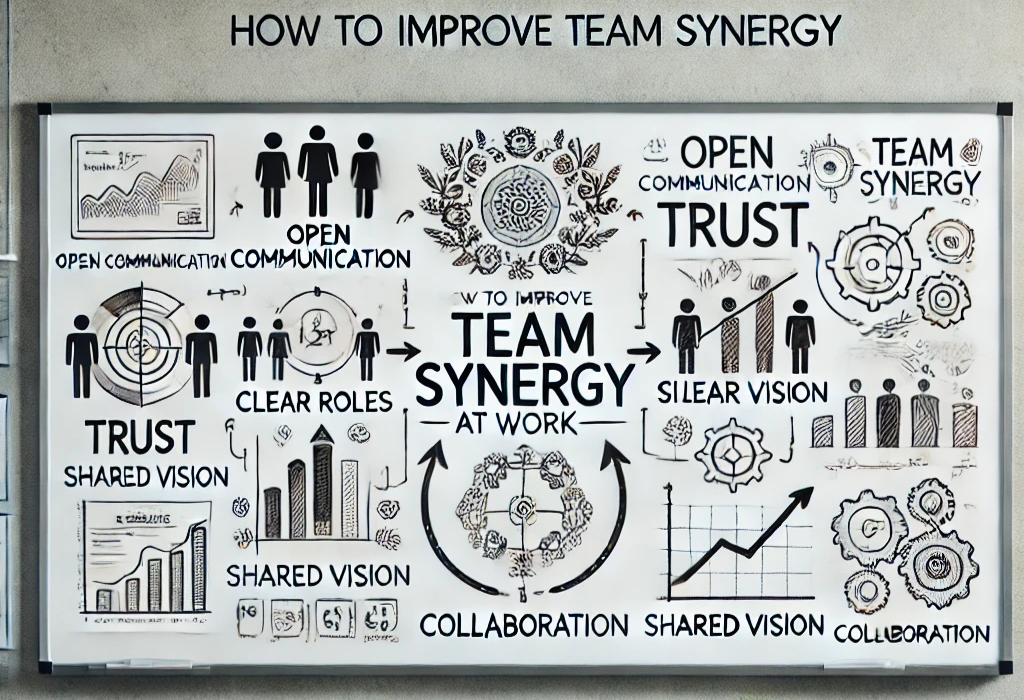“Employers and employees alike recognize the need for synergistic cooperation in the workplace. In fact, more than 50% of workers in the United States say that collaboration is a key aspect of their jobs, and 75% consider effective teamwork and collaboration to be very important in the workplace.” – Carla Groenewegen, Motion.
Teams that harness the power of synergy can achieve outcomes that exceed individual capabilities, resulting in enhanced creativity, efficiency, and morale. However, achieving team synergy is not automatic; it requires intentional strategies and a commitment to effective communication and collaboration. This article explores the importance Team Synergy in the workplace, its benefits, and practical ways to encourage it.
What does the term synergy mean?
Team Synergy is group interactions or cooperation that gives rise to a whole that is greater than the simple sum of its parts. For example, team synergy is achieved when two or more people work together to create a better solution than either could alone.
Why is synergy important in Teams?
Synergy is a key component of any team that endeavors to be successful. Whether the team works in a traditional office environment, remotely, or in labor-intensive workplaces, synergy is the glue that makes all teams effective, cohesive, and high-performing. When team members are synergetic, they exchange information with ease, communicate clearly, and work together seamlessly.
“The concept of 1 + 1 > 2 symbolizes the essence of team synergy. This mathematical anomaly is symbolic of how a team’s combined efforts, talents, and strengths can lead to results that exceed the total of what each individual could achieve separately.” – ActiveCollab Team.
What are the benefits of High levels of Team Synergy?
High levels of team synergy offer several significant benefits that can transform the way a team operates. Consider the following:
1) Enhanced Creativity and Innovation
When team members exchange knowledge and information effectively, they are able to pool diverse perspectives and expertise. This dynamic facilitates brainstorming, idea generation, and innovative solutions that surpass what individual members could achieve on their own.
2) Improved Problem-Solving
A synergistic team tackles challenges more effectively than teams that lack in it. In this work environment, team members build on each other’s strengths, address weaknesses collectively, and arrive at well-rounded solutions faster.
3) Greater Efficiency and Productivity
Synergy streamlines processes by ensuring all team members understand their roles and how they fit into the larger goal. This role clarity minimizes redundancies and improves workflow, leading to higher productivity levels.
4) Strengthened Team Morale
High levels of team synergy promote a positive work culture where members feel valued, heard, and supported. This cohesion increases job satisfaction, morale, and motivation.
5) Higher Quality Output
Collaborative team efforts lead to more thorough work, as each member’s input adds depth and precision. The result is a higher standard of output that meets or exceeds expectations.
What happens when Team Synergy is Lacking?
When team synergy is missing, several adverse outcomes can arise:
- Increased Miscommunication: Teams lacking in synergy may face difficulties conveying ideas clearly, leading to confusion and errors.
- Lower Productivity: Disconnected teams are less efficient as duplicated work or overlooked tasks become more frequent.
- Decreased Morale and Engagement: Motivation decreases when team members do not feel part of a cohesive unit. Employees may become disengaged, affecting their contribution and job satisfaction.
- Higher Turnover Rates: A prolonged lack of synergy can lead to frustration and burnout. Talented team members may leave a company in search of work environments where they feel more connected and valued.
- Reduced Quality of Work: Without synergy, collaboration becomes superficial, impacting the quality of results and potentially leading to project failures or client dissatisfaction.

Companies that Focus on Developing Team Synergy
Here are three examples of companies known for focusing on and benefiting from high levels of team synergy:
Google emphasizes synergy through its collaborative culture. The company uses open office spaces, cross-departmental projects, and tools like Google Meet and Google Workspace to enhance communication and teamwork. Google’s famous “20% time” policy encourages employees to spend part of their workweek on projects outside their regular duties, facilitating entrepreneurship and innovation. The policy also provides opportunities for team members to collaborate across different departments. This approach has led to some of Google’s most successful products, including Gmail and AdSense.
Salesforce
Salesforce is dedicated to building a cohesive team environment based on the “Ohana” culture, which means “family” in Hawaiian. The concept focuses on building trust and developing a sense of community among employees. Salesforce actively promotes open communication, holds team-building events, and aligns employees with a shared mission of helping clients succeed. This synergy-driven approach has been instrumental in Salesforce’s rapid growth and innovation in cloud technology.
Pixar
Pixar is known for its creative synergy, where teams of animators, artists, and engineers work together intensively to create groundbreaking films. Pixar encourages all employees, regardless of role and background, to contribute ideas and feedback through its “Braintrust” meetings. This process allows team members to build on each other’s strengths and perspectives, creating higher-quality films. Pixar’s commitment to team synergy is widely credited for its consistent success and high-quality output in animated movies.
These companies demonstrate how synergy, achieved through open communication, trust-building, and cross-departmental cooperation, leads to innovation, high-quality output, and a positive workplace culture.
Five Tips for Improving Team Synergy
I) Encourage Open Communication
Establish a culture where team members feel comfortable sharing their thoughts and feedback. Company leaders should conduct regular check-ins, team meetings, and open forums to help reinforce trust and transparency. Ensure everyone’s voice is heard, and actively listen to contributions. Use collaborative tools like Slack, Microsoft Teams, or Trello to keep communication consistent.
II) Define Clear Roles and Responsibilities
Ambiguity in roles can hinder collaboration. Define each member’s responsibilities clearly, ensuring everyone knows their tasks and how they contribute to the team’s overall goals. This alignment prevents overlap and confusion while maximizing each member’s strengths.
III) Build Trust Among Team Members
Trust is the cornerstone of synergy. Encourage team-building activities that help members bond outside of work tasks, such as workshops, team lunches, or virtual games for remote teams. Trust can also be cultivated through transparency, reliability, and demonstrating empathy during challenges.
IV) Promote a Shared Vision
Ensure the team understands and is aligned with the overall objectives of the project or company. A shared vision inspires commitment and helps team members stay motivated and collaborative. Regularly revisit this vision to reinforce its importance and keep everyone on track.
V) Provide Opportunities for Collaboration
Create structured opportunities for team members to collaborate, such as brainstorming sessions, cross-departmental projects, or pairing up on tasks. Collaborative technology, like shared documents and cloud-based platforms, can facilitate teamwork and improve workflow, especially for remote teams.
Key Takeaways: Improving Team Synergy
- Synergy Matters: Synergistic teams communicate well, collaborate smoothly, and feel more connected. This leads to more significant innovation, efficient problem-solving, and a positive work environment.
- Consequences of Poor Synergy: Low levels of synergy in teams lead to low morale and motivation, resulting in reduced productivity, frustration, and turnover.
- Components of Synergy:
- Encourage Open Communication: Create a culture where ideas flow freely.
- Clarify Roles: Ensure everyone knows their tasks and how they contribute.
- Build Trust: Strengthen bonds through team-building and transparency.
- Promote a Shared Vision: Align on common goals to keep motivation high.
- Provide Collaboration Opportunities: Use tools and structured activities to foster teamwork.
“Synergy – the bonus that is achieved when things work together harmoniously.” – Mark Twain.
Final Comments
Synergy is a key ingredient of effective teams. Teams that are synergetic demonstrate high levels of creativity, productivity, and group morale. Achieving synergy requires deliberate action by company leaders to encourage open communication, trust, and shared purpose. Hence, implementing the five actionable tips can help teams overcome challenges, work more cohesively, and deliver high-quality results.
Thank you for reading our article!
TimeWellScheduled is a secure online time and attendance software 100% tailored to meet your scheduling needs! In Addition, our cloud-based scheduling solution optimizes employee attendance tracking, simplifies payroll administration, and enhances staff management capabilities. Plus, our service is free for up to 10 employees!
Click here to download our (Excel) employee scheduling template; It’s free!





